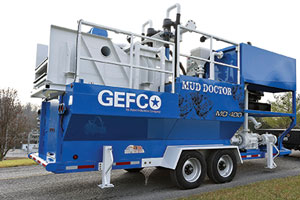How to Optimize Drilling Solids Control

Article Index:
- Identifying Key Changes
- Creating a Prototype
- Destroying Large Solids
- Hydrocyclones
- Mixing New Fluid and Cleaning at the Same Time
- New Technology Is Only as Good as Its First Customers
Although this research and design process has had great success, it has also failed grandly. I have spent the last four years working with solids control in North and South America. I have watched solids control units excel in the Peruvian desert that failed grandly when used in Nevada. The only thing that changed from Peru to Nevada was the customer’s expectations of the function of the unit. Our goal is to align our design process with our customers’ expectations and create technology ready for the field.
 |
| Columnist Brock Yordy says he’s seen customer expectations in different areas treat the same solids control system very differently. He and his company, GEFCO, hope they’ve hit a sweet spot with the new Mud Doctor. Source: GEFCO |
Identifying Key Changes
Our first design step was to head into the field to identify key changes or problem areas that could be improved. We traveled to several parts of the country and talked to drillers in the water well, geothermal, geotechnical and construction industries. The process for mud cleaning is pretty much the same for each industry. The cleaning process starts by pumping drill solids from a pit to a scalping shaker. The scalping shaker removes the large solids and allows smaller solids to fall into a tank designated as a “dirty tank.” Next, the dirty tank fluid is pumped through a hydrocyclone creating an underflow and overflow. The underflow is a concentrated solids waste stream. The overflow is clean drilling fluid that is ready to be pumped back down hole. The efficiency of solids control depends on the type of shakers and cones used. Linear shakers allow for better fluid solids separation. Systems with de-sanders and de-silter cone manifolds are able to remove a wider range of solids creating a cleaner mud. Finally, solids control systems with separated tanks for cleaning and active system work more efficiently than single-tank baffle systems.
Creating a Prototype
After gathering information from the field, we took everything we learned and began to determine what we wanted out of our solids control system. First, we identified that large solids created down hole by the bit would be ground up into smaller solids causing the solids control unit to work harder. We wanted to find a way to pump solids from the pit to the scalping screen without creating hundreds of smaller particles. Next, we wanted to use better hydrocyclone technology. Finally, we identified that a solids control unit could be more efficient and could save money on drilling fluids if it could mix new drilling fluids separate from the active system. The current solids control units in the field could clean mud or mix mud but not effectively at the same time. This is not some huge secret; it is just the way most solids control units are laid out.
After identifying our three top needs, we started to create our prototype system. Our goal was to create a unit that could keep up with 400 gallons per minute cleaning capabilities without creating more solids during the cleaning process and separately mix new drilling fluid as needed. Our motto throughout the design process was, “It is never too late to shoot the prototype.” As the first two months of the design process wrapped up, we were right on track to improve upon our three major needs: keeping large solids intact, implementing better hydrocyclones and mixing new drilling fluid without stopping.
Destroying Large Solids
A solids control unit is only as efficient as the smallest drill solid that it can remove. Therefore, the goal should be to keep the solids as large as possible and remove them from the dirty drilling fluid. We identified this need on day one in the field. Large solids that continue to be crushed or blended into smaller particles created more work for the solids control unit. Our solution was to first choose a low impact pickup pump to move the solids from the pit to the scalping shaker. Next, we determined a high “G” linear shaker capable of processing 400 gallons per minute would allow our solids control system to remove large intact solids quickly and efficiently.
Hydrocyclones
Hydrocyclones have been used for solids removal in the drilling industry for more than half a century. They started out as “that fancy technology” the oil field uses, and now they are “that antiquated technology” the oil field once used. Cyclone technology continues to be used because it’s simple, low-cost and easy to maintain. To work properly, hydrocyclones require the right psi and gallons per minute to create proper fluid and solids removal. The design team wanted to push the industries’ comfort level on hydrocyclones. We were able to find large 6-inch hydrocyclones that could treat 226 gallons per minute per cone. By increasing the cone capacity, the solids control system could clean large solids at 400 gallons per minute and fine solids at 452 gallons per minute. A system that is capable of cleaning more fine solids than large solids will prevent fine solids from building up in the dirty tank.
Mixing New Fluid and Cleaning at the Same Time
The biggest misconception in solids control is to believe that it is effective to mix new drilling fluids into an active system. The ultimate purpose of solids control is to maintain a low-solids drilling fluid with the required properties for soils being drilled. Any time water or drilling fluid additives are added directly to the active system, the fluid properties start to change. In order to properly mix new drilling fluids, operators must have clean pre-treated water, larges amount of shear, and time to completely hydrate all bentonites and polymers. Un-yielded bentonite and polymers cost a drilling company money for two reasons. First, un-yielded products take more to achieve required viscosity. Second, un-yielded products are the hardest contaminant to remove from water-producing formations. Our solution is a third tank dedicated to mixing drilling fluids. The 200-gallon auxiliary tank is designed to mix fluid fast and efficiently. Once the fluid is fully hydrated, the auxiliary tank can meter the new fluid into the active system while maintaining required fluid properties. Also, the auxiliary tank can be used to mix loss circulation to stop or prevent total fluid loss when drilling problematic zones.
New Technology is Only as Good as its First Customers
During the next six months, our solids control will be tested throughout the country. Changes and modifications will be made as needed to create an extremely efficient system. We will work closely with our customers to continue the R&D process. The goal for the GEFCO Mud Doctor project is to deliver a piece of equipment ready for the field. By working closely with our customers and welcoming feedback, we will continue to improve upon the next generation. It is our job to effectively complete the R&D process and your job to make money.
Brock Yordy is product manager and drill trainer for GEFCO, an Astec Industries Company. Contact him at byordy@gefco.com.
Video Online
National Driller spoke with columnist Brock Yordy about the company’s new Mud Doctor system at the recent Groundwater Expo. See the video at http://bcove.me/4xiid44j.Looking for a reprint of this article?
From high-res PDFs to custom plaques, order your copy today!









